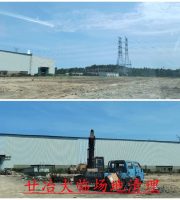Limited by hoisting capacity.
At the same time, grooving accounts for about half of the construction period of diaphragm wall, so improving its grooving efficiency can also speed up the construction progress.
When determining the form of guide wall, the following factors should be considered: I) characteristics of topsoil; II) load cases; III) possible impact of diaphragm wall construction on adjacent buildings; IV) height of groundwater level and change of groundwater level.
It is applicable to soil layers with weak bearing capacity such as miscellaneous fill and soft clay.
It is applicable to the case where the load acting on the guide wall is very large, and the length of its protruding part can be calculated and determined according to the load.
Protective layer: temporary wall greater than 60mm; Permanent wall shall be greater than 100mm.
Stability analysis of diaphragm wall (1) stability analysis of mud tank wall factors affecting the stability of mud tank wall: formation property, mud level height in the tank, mud proportion, underground water level, tank side load, one-time grooving length, depth of the tank, mud tank wall stability analysis method: two-dimensional wedge analysis method, three-dimensional analysis method considering arch effect, grooving machine currently used by grooving equipment, According to the grooving mechanism, it can be divided into grab type, rotary type and impact type.
Guide wall construction ① function of guide wall a.
③ The construction of the guide wall is generally C20 concrete pouring, and the reinforcement is usually φ 12~ 14@200 。 The clear distance between guide walls on both sides shall be about 40mm wider than the thickness of diaphragm wall.
It plays the role of retaining soil during grooving; c.
Precast reinforced concrete structure.
The waste mud shall be separated by chemical and mechanical methods, the water shall be discharged, and the mud can be filled.
Select appropriate materials and mix proportion.
It is applicable when the groundwater level is very high and well point dewatering is not adopted.
Heavy load support platform; d.
II) the slurry shall be prepared by the high-speed rotation of the high-speed rotary mixer to mix the slurry evenly.
1 – multi head drill; 2 – rack; 3 – mud suction pump; 4 – vibrating screen; 5 – hydrocyclone; 6 – mud mixer; 7 – screw conveyor; 8 – mud pit; 9 – mud sedimentation tank; 10 – slurry delivery pipe for slurry replenishment; 11 – joint pipe; 12 – joint pipe jacking frame; 13 – concrete pouring machine; 14 – concrete bucket; 15 – hopper on concrete conduit; 16 – bentonite; 17 – construction method and construction process of track underground diaphragm wall: guide wall construction, slurry wall protection, grooving, reinforced concrete construction and joint treatment.
Control the construction accuracy of diaphragm wall; b.
The mechanical treatment method usually uses vibrating screen and cyclone.
China’s Metro Design Code stipulates that the wall inclination of continuous wall shall not be greater than 1 / 150, and the local protrusion shall not be greater than 100mm, and the wall shall not invade the tunnel clearance of the main structure.
Table 6-2-7 Mud funnel viscosity Table 6-2-8 viscosity of mud funnel (mud circulation state) ③ grooving essentials to ensure the flatness of the site and the foundation bearing capacity of the surface layer, ensure the normal operation of various construction machinery in the operation site, adjust at any time and ensure the verticality of the grooving machine, timely supply the wall protection mud with reliable quality, pre drill and guide, and strengthen the desilting at the bottom of the groove..
② Slurry wall protection is still the main method to maintain the stability of continuous wall trough wall.
Advantages and disadvantages of diaphragm wall construction: (a) large wall stiffness and good integrity; (b) Applicable to various geological conditions; (c) It can reduce the impact on the environment during project construction; (d) The reverse construction method can be carried out, which is conducive to accelerating the construction speed and reducing the project cost.
The grooving of slurry treatment system is a key process in the construction of diaphragm wall.
The top surface of the guide wall shall be about 100mm higher than the ground.
The thickness of continuous wall depends on geological conditions, foundation pit depth and trenching equipment, including 1000px, 1500px, 2000px, 3000px, etc.
(2) Precast reinforced concrete continuous wall prestressed reinforced concrete.
Steel fabricated structure; c.
L-shaped guide wall is applicable to the case that the back wall of surface soil excavation cannot stand vertically.
Cast in situ reinforced concrete structure; b.
① Factors affecting the determination of the length of the trough section: geological conditions; Ground load; Lifting capacity of lifting machinery; Concrete supply capacity per unit time; Volume of mud pit (tank); The area occupied by the construction site and the time for continuous operation.
The accuracy of grooving is one of the keys to ensure the construction quality of diaphragm wall, especially the verticality, which must meet the design requirements.
The wall reinforcement shall be calculated according to the strength and crack resistance.
② Form of guide wall a.
The spacing of reinforcement shall not be less than 80mm.
Gravity settlement treatment is a method of settling soil slag by using the density difference between mud and soil slag.
Mud preparation plant mud plant III) the regeneration treatment methods of mud mainly include mechanical treatment and gravity sedimentation treatment, preferably a combination of the two methods.
Control the placement time in the slot.
It is applicable to the case of good surface soil (such as dense cohesive soil) and small load on the guide wall.
Γ The U-shaped guide wall is suitable for good surface soil, has sufficient foundation bearing capacity, and can maintain the vertical self-reliance of the side wall during the construction of the guide wall.
II) the viscosity of mud can be measured by funnel viscometer.
(c) If the diaphragm wall is only used as a temporary retaining structure during construction, the cost may be reduced High, not economical enough.
After the formwork of the guide wall is removed, two wooden supports shall be set every 1m along its longitudinal direction.
Generally, the density of newly prepared mud shall be less than 1.05; After the completion of grooving, the density of mud in the groove shall not be greater than 1.15, and the density of mud at the bottom of the groove shall not be greater than 1.25.
Disadvantages: (a) the treatment of mud waste liquid will not only increase the engineering cost, but also reduce the water content of mud Imperfect technology or improper treatment will cause new environmental pollution; (b) Tank wall collapse.
Applicable to adjacent buildings, the side with adjacent buildings shall be properly strengthened.
Table 6-2-5 General mix proportion of bentonite slurry ③ performance index of slurry Table 6-2-6 Mud performance index table ④ preparation and treatment of mud I) mud demand Where Q – Total mud demand (M3); V – total designed excavation volume (M3); N – number of unit slot sections; K1 – slurry recovery rate (%) during concrete pouring, generally 60% ~ 80%; K2 – mud consumption rate (%), generally 10% ~ 20%, including mud loss such as mud circulation, soil dumping, mud skin formation, mud leakage, etc.
Classification of construction sequence continuous wall structure and structure of underground continuous wall according to its stress characteristics, the continuous wall supporting foundation pit can be divided into four types: temporary wall: single-layer wall composite wall (1) cast-in-situ reinforced concrete wall slab continuous wall.
Generally, the length of groove section is 3 ~ 8m, and there are 10m or even longer.
Maintain stable mud level.
Construction sequence of guide wall: site leveling → survey and setting out → trench excavation → pouring of guide wall cushion concrete → reinforcement binding → formwork pouring concrete → maintenance → setting up transverse support guide wall for measurement and positioning Guide wall excavation reinforcement binding guide wall formwork support guide wall concrete pouring erection of wood support or brick support slurry wall protection ① role of slurry wall protection – hydrostatic pressure, liquid support, formation of mud skin, maintenance of soil wall stability, sand carrying – high viscosity, suspension of soil slag and cooling machines and tools – reducing bit temperature, Reduce drilling tool wear and earth cutting lubrication – reduce the difficulty of soil excavation ② mud composition wall protection mud is mainly bentonite mud, which is composed of bentonite, water and some admixtures.
In order to ensure that the mud level in the guide wall is more than 1m higher than the groundwater level, it is necessary to lift the guide wall above the ground.
i) The mud density should be measured every two hours.


